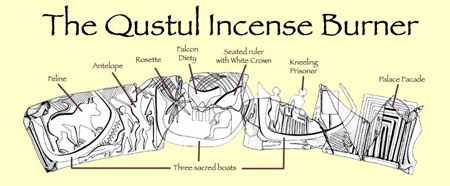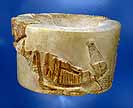
Could this be a Nubian object with Egyptian images?

This incense burner is distinctively Nubian in form. Carved in the technique of Nubian rock art, it is decorated on the rim with typical Nubian designs. It was found in the tomb of a Nubian ruler at Qustul and incorporates images associated with Egyptian pharaohs: a procession of sacred boats, the White Crown of Upper Egypt, a falcon deity, and the palace facade called a serekh. It appears to represent a ritual that involved a royal procession by boat to a palace.
How did Nubia relate to Egypt during the A-Group?
The scenes depicted on the Qustul Incense Burner have excited considerable interest and discussion - why would seemingly Egyptian symbols have been used in Nubia?
One interpretation is that Nubian A-Group rulers and early Egyptian pharaohs used related royal symbols. Similarities in rock art of A-Group Nubia and Upper Egypt support this position.
Another view suggests that the decoration was carved by Nubians in imitation of Egyptian art and rituals. In this perspective, A-Group Nubian rulers would have emulated the symbols of Egyptian pharaohs, whose prestige and power were evident.
The best chances of resolving this question lie in further exploration of areas of Nubia that are still accessible, and in excavation in the centers of early Egypt, where further evidence of the development of pharaonic traditions may be found.
Qustul Incense Burner
Limestone
A-Group (3200-3000 BC)
Qustul, Cemetery L, tomb 24
OIM 24069

